SURFACE OF CONSTANT SLOPE, SANDPILE SURFACE
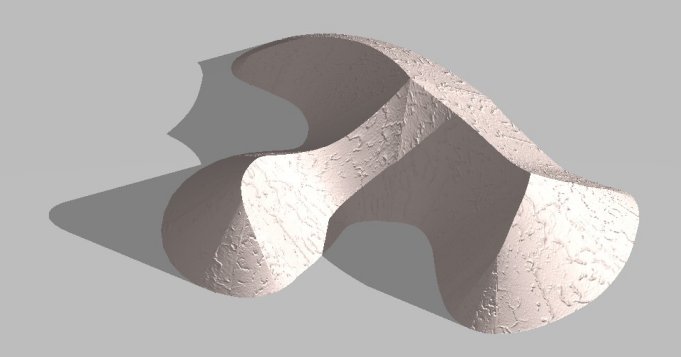
Figure made by Robert March.
| next surface | previous surface | 2D curves | 3D curves | surfaces | fractals | polyhedra |
SURFACE OF CONSTANT SLOPE, SANDPILE SURFACE

Figure made by Robert March.
| Surfaces studied by Monge in 1807, Roger Iss in 1985.
Other name: embankment. |
| Partial differential equation: Cartesian parametrization derived from the cuspidal edge:
The area of a portion of surface is equal to the area
of the projection on xOy divided by |
A surface of constant slope is a surface for which
the slope with respect to a reference plane remains constant at all points.
In other words, the tangent plane forms a constant angle
different from zero with a fixed plane (or with a fixed line, normal to
the previous plane); the surfaces of constant slope are therefore to surfaces
what the helices are
to curves.
The slope lines of such a surface, assumed to be of class C2, are linear and the tangent plane is constant along each of them; the surfaces of constant slope are therefore portions of developable surfaces.
Inversely, a developable surface, other than a cone or a cylinder, is a surface of constant slope if and only if its generatrices are always tangent to a helix (which is the cuspidal edge of the surface).
Here are various characterizations of the surfaces of constant slope:
- the slope
lines, for a given vertical direction, are linear.
- the level
lines are parallel.
- envelope of a plane forming a fixed
angle with a given plane.
- portion of a developable ruled surface
the generatrices of which form a constant angle with a fixed plane (in
other words, which all have the same slope), in yet other words, the directrix
cone of which (union of the lines passing by a given point and parallel
to the generatrices) is of revolution.
- portion of cone, of cylinder
or of tangent
developable of an helix.
A complete surface of constant slope is entirely characterized
by one of its level curves (called directrix) and the angle ,
or by its cuspidal edge and the angle
.
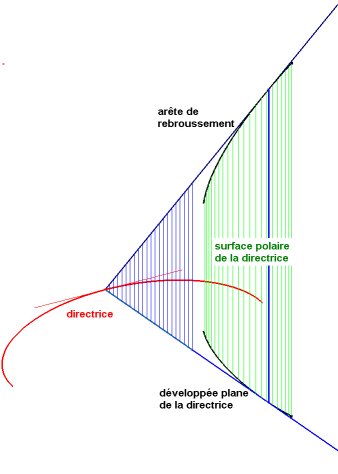 |
The cuspidal edge,
envelope of a normal to the directrix, is an evolute
of the directrix, and it is a helix for the polar
developable of this directrix, which is the cylinder constructed on
the planar evolute of the directrix.
Inversely, the directrix is an involute of the cuspidal edge. The projection of the cuspidal edge on the plane of the directrix is the envelope of the normals to the directrix, i.e. its planar evolute. |
These surfaces have the remarkable property that they can be physically modeled, in part, by saturated sandpiles.
Indeed, a grain of sand, placed without initial speed on a sand pile rolls and slides if and only if the tangent to the slope line forms with the horizontal an angle at least equal to a value that depends on the sand used (around 30°), and its trajectory is a slope line.
Similarly, embankments, ballast, rubble, scree, have a
surface that approximates a surface of constant slope.
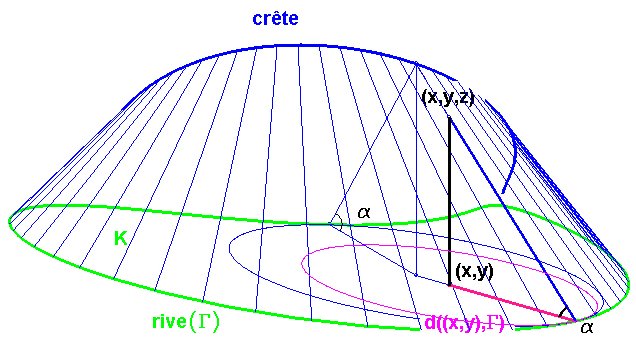 |
Given a compact K of xOy the boundary of
which is a curve (G), define the sandpile
surface with bank (G), as the surface
with equation |
This surface is composed of a part of the surface of constant slope with directrix (G) to which can be added portions of cones of revolution.
It is the envelope of the family of trunks of cones of revolution with angle at the vertex equal to the complement of a and the base disk of which is included in K and bitangent to its boundary (the bank (G)). The locus of the vertices of these cones is called the ridge; it is the curve the projection of which is included in the set of points at same distance of at least two points on (G), sometimes called the skeleton of this curve (see equidistance curve).
Examples (for the figures, we chose an angle of 30°):
| directrix (or base) |
(in black the slope lines, in red, the cuspidal edge) |
(in red, the ridge) |
| involute of a circle | developable
helicoid
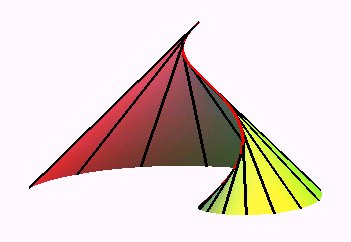
the cuspidal edge is a circular helix |
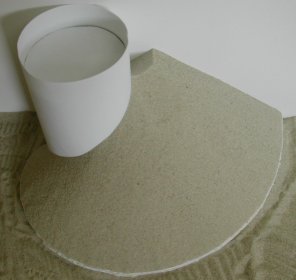 |
| ellipse |

the cuspidal edge is a tetracuspid helix |
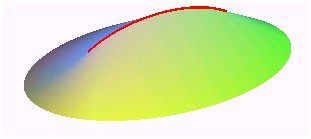
the ridge is the portion of ellipse with vertices the foci of the base ellipse 
spoon of semolina |
| parabola |

the projection of the cuspidal edge (not visible here because it is too high) is a semicubical parabola. |

the ridge is parabolic |
| cycloid |

the cuspidal edge is a cycloidal helix |
|
| cardioid |
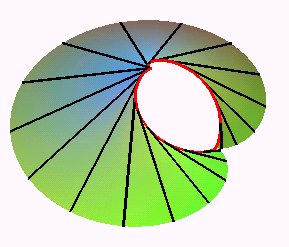
the cuspidal edge is a cardioidal helix |
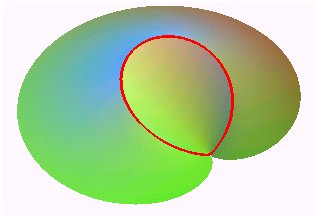
the ridge is a Viviani curve (intersection cone cylinder) |
| peanut |
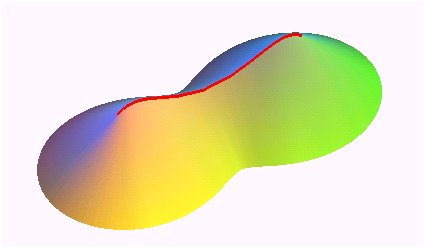 |
|
| two circles or lines |

the ridge is a conic (here a parabola) |
Other figures owed to Robert March:
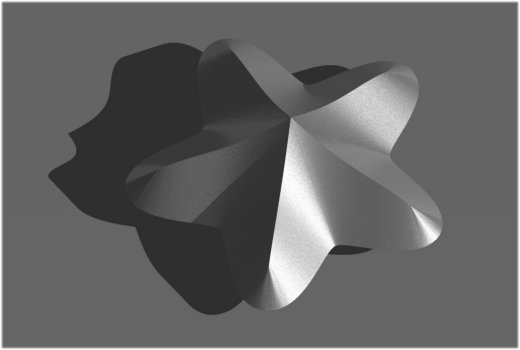 |
 |
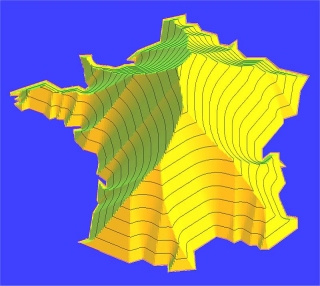 |
France as a sandpile: the projection of the highest point gives the farthest point from the boundary (at 10km north of Bourges). |
 |
 |
| next surface | previous surface | 2D curves | 3D curves | surfaces | fractals | polyhedra |
© Robert FERRÉOL 2017